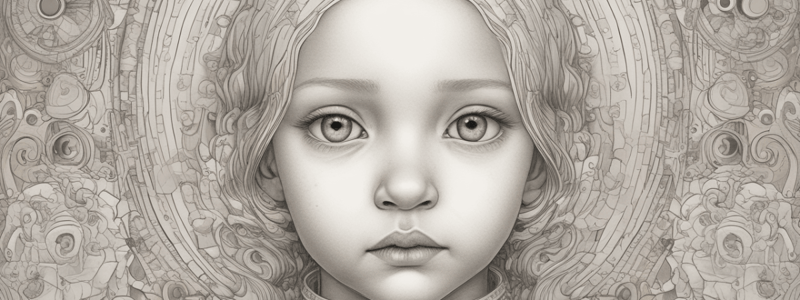Podcast
Questions and Answers
At what age can infants lift their chins from the floor when prone?
At what age can infants lift their chins from the floor when prone?
- 2-3 weeks (correct)
- 3 months
- 4-5 months
- 5-10 weeks
Which age range marks the development of goal-directed reaching while lying on stomachs propped on one arm?
Which age range marks the development of goal-directed reaching while lying on stomachs propped on one arm?
- 1 year
- 6-8 months
- 12-18 weeks
- 4-5 months (correct)
What skill do infants start developing around 5 months related to object interaction?
What skill do infants start developing around 5 months related to object interaction?
- Opening their hand to match the object's size
- Matching the size of the object with their grip (correct)
- Pincer-gripping small objects
- Changing their hand orientation to match the target
When do infants usually discover varying surfaces of objects and the relations between them?
When do infants usually discover varying surfaces of objects and the relations between them?
At what age can infants coordinate their head and eye movements to follow objects smoothly?
At what age can infants coordinate their head and eye movements to follow objects smoothly?
Which statement is true about the development of manual exploration in the womb?
Which statement is true about the development of manual exploration in the womb?
What type of facial expressions do infants show during goal-directed reaching when lying on their back?
What type of facial expressions do infants show during goal-directed reaching when lying on their back?
Which age marks the time when infants can catch objects moving at different speeds and from behind an occluder?
Which age marks the time when infants can catch objects moving at different speeds and from behind an occluder?
At what age do infants typically begin taking independent walking steps?
At what age do infants typically begin taking independent walking steps?
What is the term for the swaying motion infants make when moving or sitting, which helps them generate information about their movement?
What is the term for the swaying motion infants make when moving or sitting, which helps them generate information about their movement?
Which of the following is not a methodological problem with the visual cliff experiment?
Which of the following is not a methodological problem with the visual cliff experiment?
According to the given text, which of the following is not a common action infants take during exploration?
According to the given text, which of the following is not a common action infants take during exploration?
How does increased experience with balance and locomotion benefit infants?
How does increased experience with balance and locomotion benefit infants?
What is the typical age range for walking onset in infants?
What is the typical age range for walking onset in infants?
At what age do infants start to realize that partly occluded objects are whole?
At what age do infants start to realize that partly occluded objects are whole?
What is the effect present at around 1 year of age that is similar to the speech perceptual narrowing effect?
What is the effect present at around 1 year of age that is similar to the speech perceptual narrowing effect?
At what age do infants develop stable control over their heads, leading to successful reaching?
At what age do infants develop stable control over their heads, leading to successful reaching?
What is the significance of the development of the vestibular system and kinesthetic feedback in infants?
What is the significance of the development of the vestibular system and kinesthetic feedback in infants?
At what age do infants start to realize that 2 objects touching are 2 separate objects and not 1 object?
At what age do infants start to realize that 2 objects touching are 2 separate objects and not 1 object?
What is the age at which infants can match a familiar voice with its face and know that male/female faces are in different categories?
What is the age at which infants can match a familiar voice with its face and know that male/female faces are in different categories?
What is the most significant visual ability that improves immensely at about 6 months of age?
What is the most significant visual ability that improves immensely at about 6 months of age?
Which of the following visual abilities is relatively weak at birth but develops rapidly within 6 months?
Which of the following visual abilities is relatively weak at birth but develops rapidly within 6 months?
What is the visual ability that newborn infants have which allows them to imitate facial expressions soon after birth?
What is the visual ability that newborn infants have which allows them to imitate facial expressions soon after birth?
Which of the following visual abilities is not present at birth but develops rapidly within 6 months or so?
Which of the following visual abilities is not present at birth but develops rapidly within 6 months or so?
Which of the following visual abilities is least developed at birth and takes the longest to develop fully?
Which of the following visual abilities is least developed at birth and takes the longest to develop fully?
What is the role of experience in the development of perception, according to early theories?
What is the role of experience in the development of perception, according to early theories?
What is the first sense to develop in the womb?
What is the first sense to develop in the womb?
How can a newborn discriminate between cold and warm temperatures?
How can a newborn discriminate between cold and warm temperatures?
What is the neural pathway for pain present by in fetuses?
What is the neural pathway for pain present by in fetuses?
What can be measured in infants to determine pain levels?
What can be measured in infants to determine pain levels?
How does an infant's response to food change from birth to 3 months?
How does an infant's response to food change from birth to 3 months?
What is the role of amniotic fluid in the development of taste and smell?
What is the role of amniotic fluid in the development of taste and smell?
What is the infant's ability to discriminate between sounds in all of the world's languages called?
What is the infant's ability to discriminate between sounds in all of the world's languages called?
How does speech and language perception begin?
How does speech and language perception begin?
What is the typical age range for infants to become 'native listeners'?
What is the typical age range for infants to become 'native listeners'?
Flashcards are hidden until you start studying



